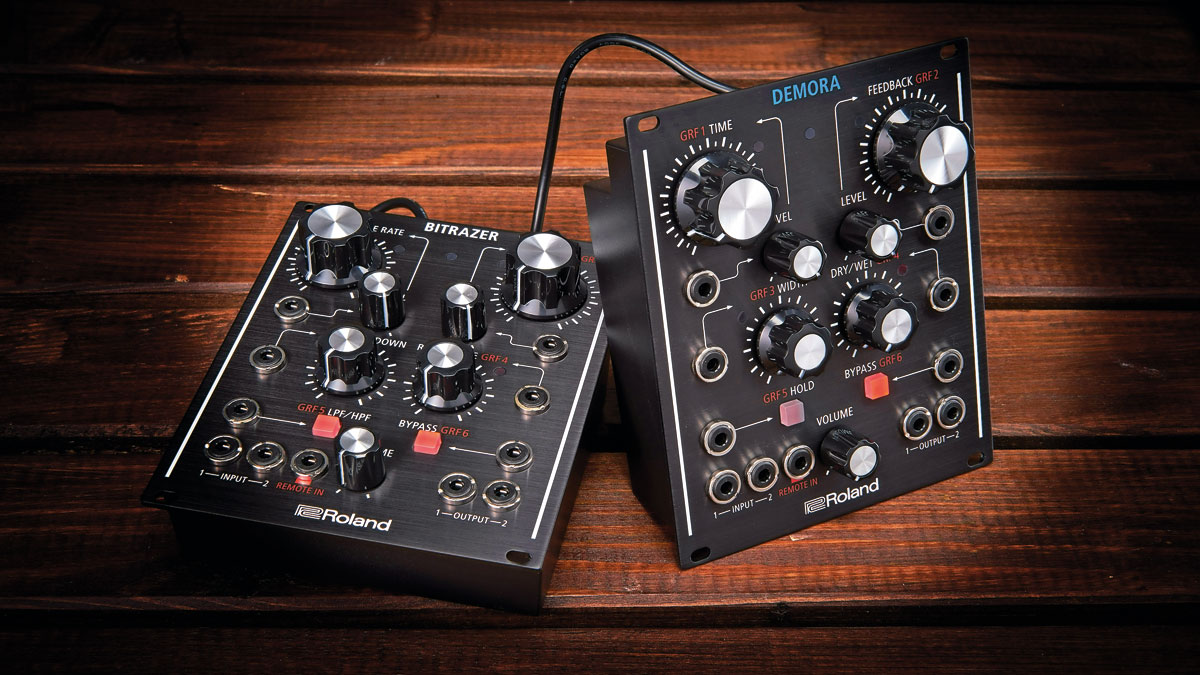MusicRadar Verdict
The Demora is a solid and flexible delay effect. But, it isn't cheap.
Pros
- +
Works brilliantly with unusual wave shapes.
Cons
- -
Pricey.
MusicRadar's got your back
Roland's Aira onslaught continues, with the company putting out four new effects boxes - the Bitrazer, Demora, Torcido and Scooper.
Today we're looking at the Demora, the range's digital delay.
As with all other elements in the Aira range, this product utilises digital process (at a sample rate of 96kHz) and comes armed with audio interfacing capabilities courtesy of its USB port.
Like the recent System-1m, the unit also features a plentiful supply of analogue ins and outs that embrace both audio and CV control, and the ability to integrate comfortably into a Eurorack modular system.
The unit's front panel is dominated by two large Moog-style knobs. Next to each is a smaller knob to adjust the amplitude of external CV signals (plugged into the adjacent 3.5mm socket). The associated LED's brightness is used for visual feedback.
A couple of sub-parameters get their own mid-size controls. These can also come under external control, but this time any CV scaling needs to happen before arriving at the unit. Two switches provide simple additional parameter or bypass on/off features, with a couple of mini-jack inputs for Gate control.
Things are rounded off with global Volume, two mono inputs and outputs and the mysterious Remote In.
As with the System-1m this box arrives with its own PSU for desktop use, but you'll also find a Eurorack power connector and four screws for racking. As such, the only connector on the rear is for USB connection to your computer.
As with all other units in the range, this handles both MIDI, audio and system updates. The box itself can also be used for general audio interfacing duties, though once again the 96kHz sample rate is fixed and Roland is not especially clear about what the ten in/out audio ports on your computer are actually routed to.
None of this is explained in the semi-generic two page owner's manual - in fact, nearly everything about using the unit is given only a cursory explanation. We understand that digital kit updates often push manuals out of date pretty quickly, but Roland's approach certainly doesn't help you get the best out of a new box of tricks.
Demora is a digital delay that can work as a stereo or (dual) mono processor. The two main controls are for delay time (which goes up to a respectable ten seconds) and feedback.
Two other knobs control Width - for skewing left-right delay effects from a mono source - and wet/dry balance. The two buttons default to effects and delay Hold, which freezes the delay buffer for perpetual repeats.
For those not familiar with delays that have 'real' controls, you are really missing out. Tweaking the delay time in real time also alters pitch, taking you from sensible repeats to insane wobbliness in a few steps.
Patching an LFO signal into the delay time CV input takes care of some of the tweaking for you, and works brilliantly with more unusual wave shapes. Smaller delay times and gentler modulation delivers a nice chorus effect.
Push the Width control and you get stereo chorus. If you don't have a separate LFO module, then you can dip into reprogramming your unit with one of 15 sub-modules that can be added via software.
Given that in its factory-state this is a very clean-sounding digital delay, you can start in a far more targeted way.
“I feel like that song had everything we needed to come back with”: Bring Me The Horizon’s Lee Malia on Shadow Moses, its riff and the secrets behind its tone, and why it was the right anthem at the right time
“I said, ‘Are we sure we can write a song about death?’”: The story of Mike + The Mechanics' classic No.1 The Living Years
“Without investment in music education our talent pipeline is at risk of drying up along with the huge opportunities for economic growth it brings”: UK Music draws up five point plan to “turbocharge” music education










